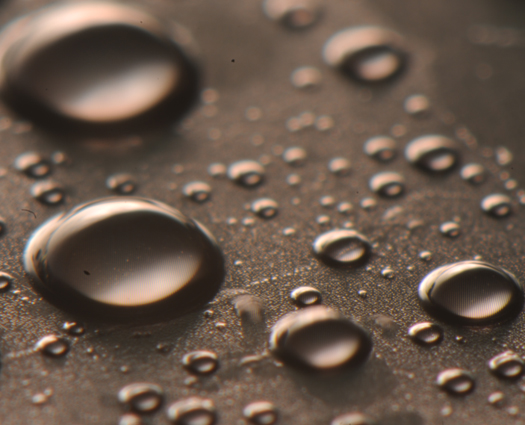

Researchers have been trying to create ultra-hydrophobic materials–materials that repel water–because condensation of vapor can interfere with the energy efficiency of industrial processes. That includes nuclear power generation, water harvesting, transportation, desalination and air conditioning. But with the right material, those resource-heavy processes could become less costly.
Enter MIT. Researchers there developed Lubricant Impregnated Surfaces (LIS), a material that is so hydrophobic, droplets of water slide right off of it. “We can show that water can slide off like ketchup,” lead researcher Kripa Varanasi says. If you’ve ever eaten a hot dog, you know that this must be one slippery material.
Even calling it a material is, well, slippery. LIS is more accurately defined as an interaction between two materials: a lubricant, such as oil, and a hydrophobic surface. The surface is covered with microscopic bumps, each about the size of a red blood cell. The lubricant then fills the space between the bumps, and together, they repel condensing water 10,000 times faster than a surface that features only hydrophobic patterning.
So is LIS the most hydrophobic material–or whatever you want to call it–in the world? Well… that’s complicated, too. There are multiple ways to measure hydrophobicity, and different kinds of experiments to show it. Take this this extremely hydrophobic nanotube material. Water bounces off of it. Watch:

Those nanotubes must be way more hydrophobic than LIS, right? After all, they instantly repel water, whereas with LIS, water just clumps up and slides off.
Not so fast. Materials like carbon nanotube forests shown here work great when isolated drops are placed on the surface. Usual hydrophobic materials show their great water-repellent properties because of air pockets on them that reduce the contact of water droplets with the underlying surface. But they lose these air pockets when you try condensing water on them. If we’re measuring contact angles as a droplet bounces off a surface, you would say that the nanotubes were the most hydrophobic. But if we’re measuring the roll-off angle conducted during a condensation experiment, LIS would win. (To measure roll-off angle, you tilt the surface and measure the angle at which the droplet starts to move.)

The MIT researchers hope that their design, which appeared in the August 2012 issue of ACS Nano, will be applicable to multiple substrates and lubricants. “What makes this attractive is that you can texture condensing tubes made out of steel or titanium. You can apply this to metals or ceramics or plastics,” Varanasi says. “If you make sure the surface and lubricant are compatible, you can accomplish this.”
